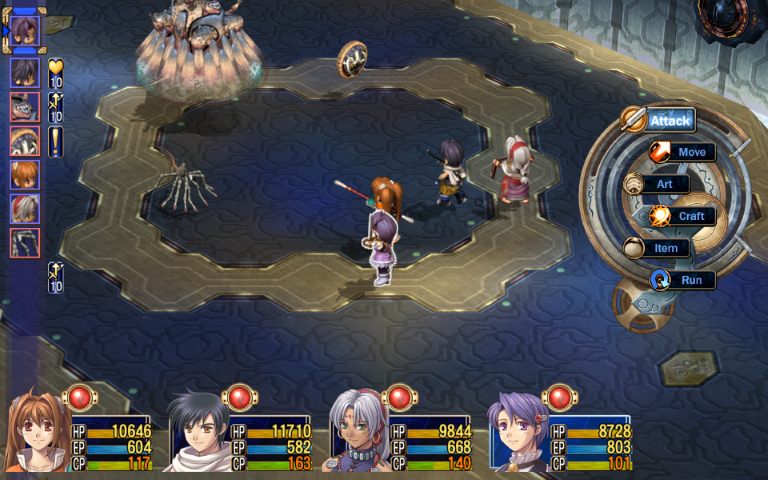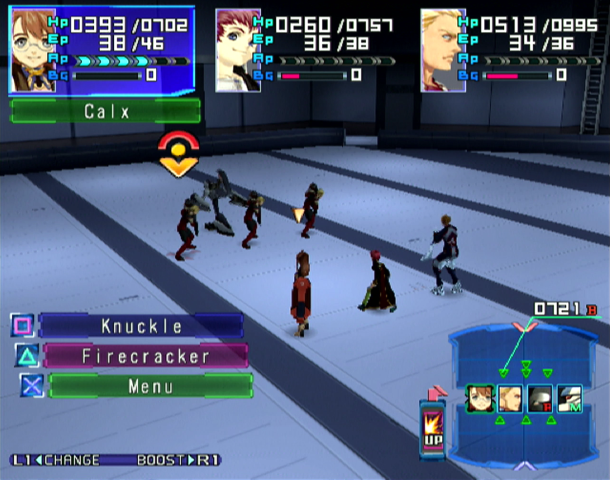After 5 years of having a proper job, I’m working on a new indie RPG. As you know from reading my (apparently annual) posts on this thing, I’m interested in older JRPG combat systems, especially from series that have been dormant for 10-15 years. I recently replayed Xenosaga Episode I to refresh my memory of the combat mechanics, which hold up a lot better than its wannabe-intellectual space opera story. There are a lot of crunchy systems in Xenosaga, but I’m particularly looking at the Event Slot, a predictable schedule of effects that change from turn to turn, and the Boost Gauge, a tool that lets the player (and enemies) steal an extra turn to take advantage of those effects. Both of those concepts are also central to the combat in Falcom’s relatively newer game Legend of Heroes: Trails in the Sky and I think it’ll be instructive to compare how the two games execute similar ideas. Of course there are plenty of turn-based RPGs where you can manipulate the turn order by various means (off the top of my head, Shadow Hearts From the New World, Radiant Historia, Bravely Default) but I’m interested in how that idea combines with an effect that distinguishes one turn from another, so that it’s not just about me getting more turns than the enemy, but getting this particular turn that will give me an advantage.
The mechanics
Xenosaga: There are four possible effects in the Event Slot that rotate in order: None, Critical Up (higher chance of critical attacks), Boost Up (earn more Boost Gauge when attacking), and Points Up (increased rewards from defeating enemies). This order never changes. The Boost Gauge is a meter that increases any time you use a normal or Tech attack; it does not increase when casting spells, using items or blocking. Normal attacks add about 1/8 of a boost, Tech attacks 1/4, and the amounts double on a Boost Up turn. A character can have up to a maximum of 3 boosts’ worth of meter stocked. However, a character cannot boost if they are currently acting or their turn is scheduled in the immediate future as depicted in the queue in the bottom right of the screen. Finally, enemies can also boost. They will sometimes boost as a counter attack, which stacks on top of any previous boost command.
Trails: There are a variety of effects, and the types of effect and their frequency vary both between battles and over the course of a single battle. They include guaranteed critical attack, increased damage, bonus loot drops for hitting (not necessarily defeating) enemies, and automatic healing of three character resources – HP, EP (cost of magic), CP (cost of skills). Some random encounters have no turn effects, but boss battles almost always have at least some increased damage & guaranteed critical turns. The schedule is randomized, but the upcoming 8-10 turns are shown on the side of the screen. Characters gain CP when dealing or receiving damage. A character with at least 100 CP can spend all their CP to execute a special skill (“S-Break”) on the next turn. Characters can have up to 200 CP; if they have exactly 200, the effect of the skill is enhanced. There is no restriction on when a character can use an S-Break as long as they have the required CP.
CP is a resource that will frequently be spent on other skills besides S-Breaks, while the Boost Gauge can only be spent on boosting. If multiple Xenosaga characters have more than one boost stocked, it is possible to chain boosts one after the other, preventing the enemy from acting for a long time (unless they also boost!) whereas a Trails character will need several turns to bank the CP required to execute their next S-Break. Finally, the most significant difference: a boosted turn in Xenosaga is no different from a normal turn, but in Trails, only S-Breaks can be used to interrupt the scheduled turn order.

Effects coming up in the next few turns of Trails in the Sky SC (left side): Heal 10%, 10% extra damage, guaranteed critical hit. All four characters are ready to use an S-Break.
The incentivized behaviors
I’ve written before about the risk-reward dynamic of the Points Up slot in Xenosaga, which incentivizes delaying the killing blow in order to get the most points out of every encounter, at the risk of allowing the enemy extra turns. The Boost system gives the player a tool to reduce that risk by blocking the enemy from taking the Points Up turn, but there are good reasons to use boost to take the Critical & Boost Up effect slots as well. Since one of the Event Slot turns increases the amount of boost earned from attacking, it is often possible for a character to boost and then earn back 75% of the BG just spent; in shorter battles this is enough of a return on investment to make it worthwhile.
Because of the randomization, the turn effect schedule in Trails tends to produce situations that require reaction from the player, rather than allowing the player to build a strategy in advance. Interrupts are harder to accomplish so you must choose carefully when in the course of the battle it is most advantageous to steal a turn. In boss battles, most of the time I would save my CP until the boss was about to get a guaranteed critical, since the large majority of S-Breaks are powerful attack skills; gaining a critical and denying one to the enemy is the most bang for your CP buck.
In both games some of the effects are beneficial only to the player – for example enemies gain no advantage from earning extra upgrade points or loot. This provides some variety in the relative value of stealing different turn effects.
The problems
Although in theory enemies earn Boost Gauge according to similar rules to players, and so should be limited in their boosting if you keep them away from the Boost Up turn, this system is entirely opaque, and frequently enemies will boost on the first turn of a battle. When they boost as a non-counter attack it will happen the moment a turn begins, before you can attempt to boost, which I suppose is better than having to try to mash buttons to beat them to it. Nevertheless, when you plan to boost on the next turn and are denied that by an enemy, it feels effectively random and therefore, to me, frustrating as hell. Although the triggers for enemy counter attacks have to be learned, they are consistent, and since they can override the player’s boost input, I think they would provide enough challenge on their own.
Also frustrating: earning Boost Gauge only from executing attacks means that taking a defensive posture is problematic. Whereas taking a big hit in Trails might push you over 100 CP, giving you an opportunity to swing momentum in your favor – very much in the spirit of Final Fantasy’s Limit Break – in Xenosaga a character who has to spend every turn healing or defending will never gain traction. There are some hideous difficulty spikes in Xenosaga, with regular enemy groups able to deal severe damage on multiple extra turns, because of the positive feedback loop of not being able to boost when you’re at a disadvantage.

Me getting my ass kicked by a random encounter 30 hours into Xenosaga Episode I. Shion has to heal the party right now instead of using the critical effect seen in the lower right. I’ll be dead in a few turns anyway.
The biggest issue I have with Trails’ S-Break system is not with the mechanics but the interface. Once you input the interrupt command you are committed to executing the skill, and can only choose a target. Many skills have a limited range, and it’s possible to completely whiff because you are just out of reach. There’s no apparent mechanical reason not to allow the player to cancel out of the attack and let the next turn proceed as scheduled. I’m always annoyed by games with grid-based movement that don’t let you test what you can do from a given position before committing (hi, FF Tactics!) and the movement undo system was the first thing I prioritized back when I made Demon Thesis.
My takeaways
In principle I prefer Xenosaga’s consistent, repeating cycle of effects more than the scrambled version in Trails in the Sky, but there’s no question that Trails executes its idea more successfully. Xenosaga would be improved by either taking away the ability for enemies to boost or at least making the rules for when they are able to boost more transparent – simply showing that they accrue Boost Gauge the same as players, and are limited by how often they can fill the meter, would go a long way to making the system feel less arbitrary. Another idea that I’m exploring in my prototype is the ability to manipulate the schedule of turn effects directly, without changing the order in which characters act. The tactical maneuver of changing an advantageous turn effect into a lesser one, or vice versa, doesn’t need to always be coupled directly to gaining an extra turn, which is an extremely powerful advantage in pretty much any combat system.
